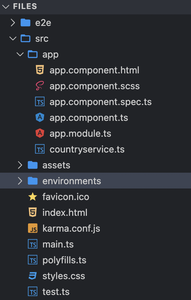Angular PrimeNG Form MultiSelect高级模板和过滤组件
Angular PrimeNG是一个开源框架,拥有丰富的原生Angular UI组件,可用于出色的造型,这个框架用于制作响应式网站,非常容易。在这篇文章中,我们将看到如何在Angular PrimeNG中使用Form MultiSelect Advanced with Templating and Filtering Component。
多选组件可用于从菜单中选择多个值。模板组件主要用于提供模板,过滤 组件用于从给定列表中过滤选项。
语法:
<p-multiSelect [options]="countries"
[(ngModel)]="selectedCountries1"
defaultLabel="Select a Country"
class="multiselect-custom">
<ng-template let-value pTemplate="selectedItems">
...
</ng-template>
</p-multiSelect>
创建Angular应用程序和模块安装。
- 使用以下命令创建一个Angular应用程序。
ng new appname
- 在创建你的项目文件夹即appname后,使用以下命令移动到它。
cd appname
- 在你给定的目录中安装PrimeNG。
npm install primeng --save
npm install primeicons --save
项目结构:完成上述步骤后,项目结构将如下所示。

示例1:本示例演示了Angular PrimeNG中带有模板和过滤组件的Form MultiSelect Advanced的基本用法。
- app.component.html
<div style="text-align:center">
<h1 style="color:green;">GeeksforGeeks</h1>
<h3>A computer science portal for geeks</h3>
<h4>
Angular PrimeNG Form MultiSelect
Advanced with Templating and
Filtering Component
</h4>
<h5>Templating</h5>
<p-multiSelect [options]="countries"
[(ngModel)]="selectedCountries1"
defaultLabel="Select a Country"
optionLabel="name"
class="multiselect-custom">
<ng-template let-value pTemplate="selectedItems">
<div class="country-item country-item-value"
*ngFor="let option of selectedCountries1">
<div>{{ option.name }}</div>
</div>
<div *ngIf=
"!selectedCountries1 || selectedCountries1.length === 0"
class="country-placeholder">
Select Countries
</div>
</ng-template>
<ng-template let-country pTemplate="item">
<div class="country-item">
<div>{{ country.name }}</div>
</div>
</ng-template>
</p-multiSelect>
</div>
- app.component.ts
import { Component } from '@angular/core';
import {
trigger,
state,
style,
transition,
animate,
} from '@angular/animations';
import { SelectItem, PrimeNGConfig } from 'primeng/api';
import { CountryService } from './countryservice';
@Component({
selector: 'app-root',
templateUrl: './app.component.html',
styleUrls: ['./app.component.scss'],
providers: [CountryService],
})
export class AppComponent {
selectedCities: string[] = [];
selectedCountries1: string[] = [];
selectedCountries2: string[] = [];
items: SelectItem[];
item: string;
cities: any[];
countries: any[];
constructor(
private countryService: CountryService,
private primengConfig: PrimeNGConfig
) {
this.items = [];
this.countryService.getCountries().then((countries) => {
this.items = countries;
});
this.countries = [
{ name: 'India', code: 'AU' },
{ name: 'Brazil', code: 'BR' },
{ name: 'China', code: 'CN' },
{ name: 'Egypt', code: 'EG' },
{ name: 'France', code: 'FR' },
{ name: 'Germany', code: 'DE' },
{ name: 'Spain', code: 'ES' },
{ name: 'United States', code: 'US' },
];
}
ngOnInit() {
this.primengConfig.ripple = true;
}
}
- app.module.ts
import { NgModule } from '@angular/core';
import { BrowserModule } from '@angular/platform-browser';
import { FormsModule } from '@angular/forms';
import { HttpClientModule } from '@angular/common/http';
import { BrowserAnimationsModule }
from '@angular/platform-browser/animations';
import { AppComponent } from './app.component';
import { MultiSelectModule } from 'primeng/multiselect';
@NgModule({
imports: [
BrowserModule,
BrowserAnimationsModule,
MultiSelectModule,
FormsModule,
HttpClientModule
],
declarations: [AppComponent],
bootstrap: [AppComponent]
})
export class AppModule { }
输出:

例子2:这是另一个例子,通过禁用输入选项,演示了Angular PrimeNG中带有模板和过滤组件的Form MultiSelect Advanced的使用。
- app.component.html
<div style="text-align:center">
<h1 style="color:green;">GeeksforGeeks</h1>
<h3>A computer science portal for geeks</h3>
<h4>
Angular PrimeNG Form MultiSelect
Advanced with Templating and
Filtering Component
</h4>
<h5>Templating</h5>
<p-multiSelect [options]="countries"
[(ngModel)]="selectedCountries1"
defaultLabel="Select a Country"
optionLabel="name"
disabled="true"
class="multiselect-custom">
<ng-template let-value pTemplate="selectedItems">
<div class="country-item country-item-value"
*ngFor="let option of selectedCountries1">
<div>{{ option.name }}</div>
</div>
<div *ngIf=
"!selectedCountries1 || selectedCountries1.length === 0"
class="country-placeholder">
Select Countries
</div>
</ng-template>
<ng-template let-country pTemplate="item">
<div class="country-item">
<div>{{ country.name }}</div>
</div>
</ng-template>
</p-multiSelect>
</div>
- app.component.ts
import { Component } from '@angular/core';
import {
trigger,
state,
style,
transition,
animate,
} from '@angular/animations';
import { SelectItem, PrimeNGConfig } from 'primeng/api';
import { CountryService } from './countryservice';
@Component({
selector: 'app-root',
templateUrl: './app.component.html',
styleUrls: ['./app.component.scss'],
providers: [CountryService],
})
export class AppComponent {
selectedCities: string[] = [];
selectedCountries1: string[] = [];
selectedCountries2: string[] = [];
items: SelectItem[];
item: string;
cities: any[];
countries: any[];
constructor(
private countryService: CountryService,
private primengConfig: PrimeNGConfig
) {
this.items = [];
this.countryService.getCountries().then((countries) => {
this.items = countries;
});
this.countries = [
{ name: 'India', code: 'AU' },
{ name: 'Brazil', code: 'BR' },
{ name: 'China', code: 'CN' },
{ name: 'Egypt', code: 'EG' },
{ name: 'France', code: 'FR' },
{ name: 'Germany', code: 'DE' },
{ name: 'Spain', code: 'ES' },
{ name: 'United States', code: 'US' },
];
}
ngOnInit() {
this.primengConfig.ripple = true;
}
}
- app.module.ts
import { NgModule } from '@angular/core';
import { BrowserModule } from '@angular/platform-browser';
import { FormsModule } from '@angular/forms';
import { HttpClientModule } from '@angular/common/http';
import { BrowserAnimationsModule }
from '@angular/platform-browser/animations';
import { AppComponent } from './app.component';
import { MultiSelectModule } from 'primeng/multiselect';
@NgModule({
imports: [
BrowserModule,
BrowserAnimationsModule,
MultiSelectModule,
FormsModule,
HttpClientModule
],
declarations: [AppComponent],
bootstrap: [AppComponent]
})
export class AppModule { }
输出:

 极客教程
极客教程